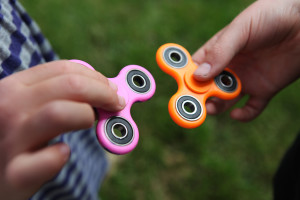Good news: cognitive science research can be SPECTACULARLY useful in guiding and informing teachers.
Less good news: that guidance isn’t always clear or prompt.
After all:
Research findings often contradict one another.
They can also contradict our deeply-held beliefs, and/or our school’s policies.
Not everyone who quotes research actually understands research, or quotes it accurately.
And so forth.
Another problem with research gets less focus: it takes so much time.
In this case: fidget spinners were a thing back in 2017!
Perhaps you — like me — frequently heard the idea that “we can give fidget spinners to students to help them get the wiggles out!”
More specifically: “fidget spinners will help those students diagnosed with ADHD let off jittery steam without wandering around or distracting others.”
At that time, those claims sounded plausible or implausible — depending on your perspective and experience. But we didn’t have any research to support or contradict them.
As one group of pediatricians wrote in 2017:
Fidget spinners and other self-regulatory occupational therapy toys have yet to be subjected to rigorous scientific research. Thus, their alleged benefits remain scientifically unfounded. Paediatricians should […] inform parents that peer-reviewed studies do not support the beneficial claims.
Well: SEVEN years later, now we do have research!
Worth the Wait
Researchers in Florida worked with a group of 60 children enrolled in a summer program for young children diagnosed with ADHD.
This program offered both academic and behavioral training over eight weeks, to better prepare these children for the upcoming school year.
Both in the first two weeks and the final two weeks, the research team gave several children fidget spinners during the 30-minute ELA class. They looked for data on these questions:
Did the fidget spinners change the amount of wandering around?
Did they change the students’ attention to the class work?
And, did they affect the other children who did not get fidget spinners?
Sure enough, the data they gleaned provide helpful classroom guidance.
Good News, Bad News
If you’re in the pro-fidget spinner camp, you’ll be glad to know that the fidget spinners did NOT lead to an increase it problems among the other students who didn’t get one.
They didn’t wander any more than usual; they didn’t pay less attention than usual. (“Area violations” and “attention violations” were the two categories tracked by researchers.)
That’s the good news.
If you’re pro-fidget spinner, the rest of the news won’t encourage you.
First: the spinners reduced wandering a bit at the beginning of the program. But they did NOT reduce wandering at the end.
Second: the spinners raised inattention levels both at the beginning and at the end of the program. And the increases in inattention were greater than the decreases in wandering.
In brief, fidget-spinner champions will not find much support here.
Questions and Caveats
No one study can answer all questions, so we should keep its limitations in mind.
What about older students? This research doesn’t explore that question.
Won’t students get better at using fidget spinners AND paying attention over time? We don’t know. (But: eight weeks is an unusually long research study.)
Don’t they benefits SOME students? Maybe. A 60-person study doesn’t really allow us to look for granular sub-populations.
A later study should show the opposite results! It certainly could.
In other words, passionate fidget-spinner advocates can ask worthwhile questions. And, we shouldn’t be too emphatic based on one study.
But we can say this:
According to this one research study, fidget spinners did not help young students diagnosed with ADHD pay attention; they did more harm than good.
Graziano, P. A., Garcia, A. M., & Landis, T. D. (2020). To fidget or not to fidget, that is the question: A systematic classroom evaluation of fidget spinners among young children with ADHD. Journal of attention disorders, 24(1), 163-171.




